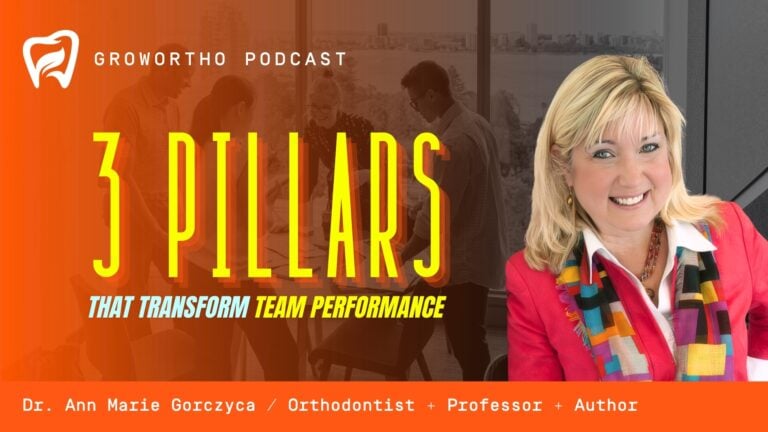Subscribe: RSS
The Three Pillars That Build Unstoppable Orthodontic Teams
Most orthodontic leaders think motivation lives in the paycheck. Add a bonus here, throw in a perk there, and watch performance soar. Except it doesn’t work that way.
True motivation isn’t bought. It’s built. Dr. Ann Marie Gorczyca proves it every day in her practice with three psychological pillars: autonomy, mastery, and purpose. When you weave these into your culture, motivation becomes self-sustaining. Your team starts driving itself forward instead of waiting for you to push.
https://www.youtube.com/watch?v=bifonMVrpwA
Autonomy: Let Your People Own The Wheel
Autonomy doesn’t mean walking away and hoping things work out. It means designing clear lanes of responsibility and letting your team steer within them.
Dr. Gorczyca gives every team member a project they own, from accounts receivable to customer service. Then she has them present results during meetings. That simple act transforms a task into a contribution. They’re not just completing assignments. They’re leading.
If you’ve hired for personality and potential over experience, this approach becomes critical. Start small. Give a new hire one job they can master, like serving as the office concierge who greets every patient. Let them win early, celebrate those wins, and expand their scope as confidence grows.
Micromanagement kills motivation faster than anything. Ownership grows it. When people feel trusted to make decisions, they begin thinking like leaders.
Try this: In your next team meeting, assign one person a recurring metric to track and report on: insurance claims, call conversions, or patient satisfaction. Let them own the mic for that topic. You’ll see confidence rise almost instantly.
Mastery: From Good Enough To Excellent
Mastery isn’t instant. It’s the drive to keep improving long after you’ve become proficient. It requires repetition, humility, and curiosity.
Dr. Gorczyca notes it takes about three years for a registered dental assistant to truly master every system in an orthodontic practice. One year to become proficient. Three years to become excellent. Twenty years to become elite.
This mindset separates thriving practices from stagnant ones. When your culture rewards mastery, people start taking pride in their precision, whether they’re handling insurance billing or seating a patient.
Think of mastery like athletic training. The best performers, from Kobe Bryant to Tom Brady, show up every day to refine the fundamentals. The same principle applies in your practice. The job isn’t to get things done once. It’s to get better every time you do them.
Try this: Set clear 30-60-90 day development goals for each team member. Focus less on speed and more on precision. Then celebrate milestones, like reducing insurance claims over 60 days or improving call conversion rates. Recognition fuels repetition.
Purpose: The Anchor That Keeps Teams Grounded
Autonomy and mastery create drive. Purpose gives direction. Without it, even your most talented team will lose steam over time.
Dr. Gorczyca’s practice lives by one powerful statement: “Smiles Change Lives.”
It’s simple, memorable, and true. Every task, from sterilizing instruments to bonding brackets, connects back to that purpose. The work isn’t just about straightening teeth. It’s about giving patients confidence and helping them leave better than when they arrived.
Purpose transforms a job into a mission. It reminds every team member that what they do matters.
Try this: Post your vision statement where every patient and team member can see it. Then weave it into your meetings. When a patient shares how treatment changed their life, tell that story. Let your team see the impact of their work in real time.
How The Three Pillars Work Together
Autonomy, mastery, and purpose aren’t separate initiatives. They’re a system.
When a new hire joins, they should immediately experience all three:
- Autonomy: A clear role they can own.
- Mastery: A path to grow through structured training.
- Purpose: A connection to why the role exists.
During meetings, rotate who presents reports to foster autonomy. Recognize small wins publicly to reward mastery. Revisit your vision often to renew purpose.
Motivation doesn’t happen by accident. It happens by design.
Four Traps That Kill Motivation
Even well-intentioned leaders can unknowingly sabotage motivation. Watch for these pitfalls:
- Micromanagement: Undermines autonomy and signals distrust.
- Speed over skill: Prioritizing volume kills the pride of mastery.
- Mission drift: When purpose isn’t reinforced, work feels transactional.
- Inconsistency: Holding some people accountable and letting others slide erodes culture fast.
If your team’s energy feels low, start by asking: “Where are we missing one of these three pillars?”
Four Steps You Can Take This Week
- Write or refine your mission statement. Make it short, clear, and emotionally resonant.
- Assign ownership. Give one team member a recurring responsibility and have them report back.
- Introduce a mastery moment. Let someone teach a quick skill or insight they’ve learned.
- Reflect on autonomy. Identify one process you can delegate more fully.
Each small change builds momentum.
The Bottom Line
Autonomy creates ownership. Mastery builds pride. Purpose gives meaning.
When you align all three, motivation stops being something you have to demand. It becomes something your team naturally expresses in their attitude, their performance, and their results.
Leadership isn’t about pushing harder. It’s about building an environment where people want to give their best. As Dr. Gorczyca proves, when you lead through autonomy, mastery, and purpose, your practice doesn’t just grow. It thrives.




